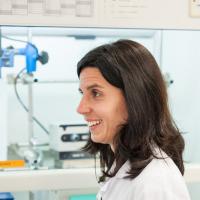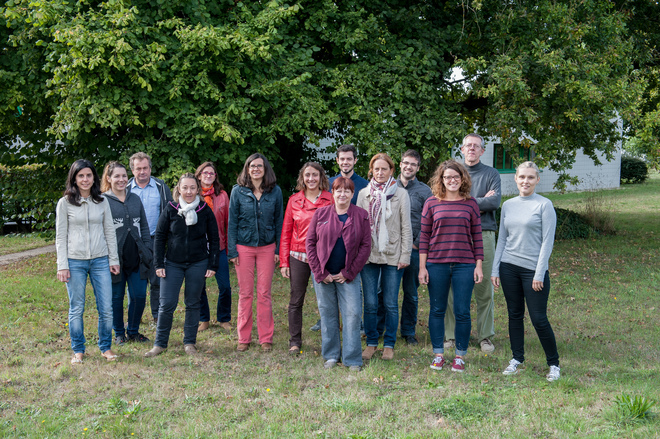
Bioeconomy 5 min
Ana in the land of the little
Like Gulliver, Ana Villares is on an extraordinary journey, making leaps and bounds in a nano-scopic world. From the discovery of physicochemical properties of plant-based polymers in Spain, to their assembly at INRA in Nantes, her story takes us to the heart of her scientific research: design new biobased materials that are reliable and sustainable.
Published on 01 December 2019
Although reserved, Ana has all the trappings of a great in her research field, which is full swing: nano-structured cellulose. “There are two major types of nano-cellulose”, she explains. “Nano-fibers, which look like spaghetti, and nano-crystals, which are more like grains of rice”. To control their mechanical uses (insulation or resistant material), use as a buffer (packaging), or optical use (electronic devices and reflective surfaces), she mobilises extraordinary skills which have become indispensable for her team.
Building the materials of the future
A solid foundation in basic research
Ana’s adventure begins on a mountaintop in Zaragoza, Spain, where it became clear after earning a Masters in Chemistry that a career in research was her calling. She went to France on a post-doc in 2013 to join INRA’s “Nanostructured Assemblies” team in the Biopolymers, Interactions and Assemblies Unit in Nantes, where she was able to put her double training in Physics and Chemistry to use.
With a solid foundation in basic research, Ana is in her element. “I love breaking down what we call thin layers: once you’ve explained those, you can control them!” she says with a bashful smile. “Our goal is to obtain, from natural polymers, the building blocks that we are going to assemble or modify in order to develop their functionalities”. Advancing knowledge in her field sparks Ana’s imagination. “We don’t make packaging materials directly, but our basic research allows us to identify those polymers that fit the bill for the job”.
Having joined INRA only three years ago, Ana’s results are impressive, notably the method she discovered of fractioning cellulose fibres using enzymes: “This defibrillation mechanism allows us to produce nano-fibres with less effort and open new doors of assembly”. The procedure, using LPMO enzymes (1), is the subject of a patent application. Ana has also developed a model for describing how cellulose is modified after absorption of hemicellulose: “Cellulose is known for being resistant, while hemicellulose, for example, dissolves in water. By studying the interactions between the two, we can, among other things, stabilize their assembly and final properties”. For Ana, “publishing results is the fruit of hard work”.
A rising star
Writing things up before starting work is very important
At the tender age of 36, Ana boasts no fewer than 65 publications in international journals. Asked what that means to her, she responds with unfeigned modesty, “It’s a balancing act between stimulation and pressure”. For Bernard Cathala, her research director in the Unit, “It goes to show her tremendous quality as a researcher and her ability to get the job done”. In other words, Ana is an exceptional scientist whose proven talent leaves nothing to chance.
Extremely organised, Ana knows that successful research depends on rigorous methodology: “It’s easy to think it’s a waste of time to write things up before starting work, but it’s very important to know where you’re going”. Bernard Cathala concurs: “Nothing goes to waste in Ana’s work. She is incredibly productive”. Ana’s great strength is knowing how to grasp all the aspects of a project, something she did with brio when she was selected for a post-doc with Agreenskills (2), or sat for the competitive exams in 2015 to become an INRA researcher. “I built my research projects with Bernard. I wouldn’t be here without the support of the team. Nobody does anything alone”. With her singsong accent, she stresses the importance of learning from everybody’s shared experiences and practices in order to move forward. For what’s at stake here is nothing less than biobased materials: “propose a viable alternative to cut back on our dependence on oil-based polymers”. Such is Ana’s wish, to use her talents to advance science toward that goal.
Next steps
“Ana is remarkable, she has tremendous potential and we hope to keep her on board!” says her research director, Bernard Cathala. And Ana, who feels right at home at INRA, agrees: “INRA has a lot to offer foreign researchers in the way of careers. I feel good here, and the team welcomed me with open arms”. In her unit, Ana has access to state-of-the-art equipment suited to her vast field of research: “Our equipment offers us a cutting-edge work environment”. As for her wanderlust, Ana is betting on quenching it through internships at labs abroad: “Seeing how others work always helps you to make progress”.

- 36 years old, born in Soria, Spain
- 2003-2004: Master in Experimental Chemistry Techniques, University of Zaragoza, Spain
- 2005-2008: PhD in Chemistry, University of Zaragoza, Spain
- 2008-2012: post-doctoral degree at the Spanish national institute of research and technology for agriculture and food (INIA), Soria, Spain
- 2013-2015: post-doctoral fellowship with Agreenskills in the research unit of Biopolymers, Interactions and Assemblies at INRA, Nantes
- since 2013: research director at research unit of Biopolymers, Interactions and Assemblies at INRA, Nantes
- Author of 65 publications in international scientific journals
- Hobbies: reading, “seeing the world”
Awards and distinctions
- 2016 INRA Promising Researcher Award
